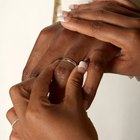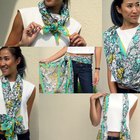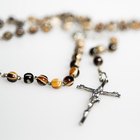
The traditional Arabic headdress goes by several names. It is called a keffiyeh, shmagh, ghutrah and an Arabic scarf. It can be worn in several different ways, either by itself or with a cap (igal) and wreath (tagiyyah) to keep it in place. The scarf was initially used to protect from the harsh rays of the sun and the whipping sands of the desert--it still serves that purpose, but has now become a symbol of Arabic culture. It is also worn at weddings and by heads of state, when it serves a purely decorative function. The scarf is a large cotton square that is woven in a distinctive checkered design. It is usually red and white, or white and black.
Wear an Arabic Headdress

Place the cap (igal) on your head.

Place the scarf on top of your head so that there are couple of inches of fabric hanging down over your forehead.

Place the wreath over your head. Wearing the scarf open like this is a formal way worn at weddings. Proceed to steps four and five for two other ways to wear it.

Take the right-hand-side corner of the scarf and drape it over your left shoulder (from front to back), as seen in www.zee.me. You can leave it like this or proceed to step five.

Take the left-hand-side corner and drape it over the left shoulder, covering the draping of the right-hand-side.
Related Articles

What Is the Jaan Arrival in an Indian ...

How to Wear a Prayer Shawl

How to Tie a Hachimaki

The Difference Between a Corsage & ...

How to Use a Veil & Cord in a Wedding

How to Wash a Pashmina Scarf

Traditional African Wedding Attire

How to Make an Easy Turban

How to Wear a Marine Corps Dress Uniform

Jewish Funeral Etiquette for Gentiles

How to Make a Pashmina Jacket

How to Wear a Scarf in Five Different ...

How to Tie a Cowboy Bandana

Can You Wear a Rosary As a Necklace?

How to Tie a Bandana Like a Gangsta

What Is an African Kufi Hat?

Mexican Wedding Traditions

How to Wear a Maang Tikka

What Can You Wear for a Hindu ...

What Do Chinese Women Wear?
References
- "Approaches to the Study of Dress in the Middle East", Lindisfarne-Tapper, Nancy; Ingham, Bruce, 1997
Photo Credits
muneer binwaber/Demand Media